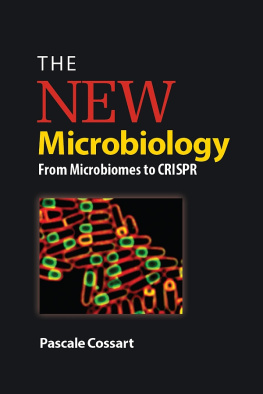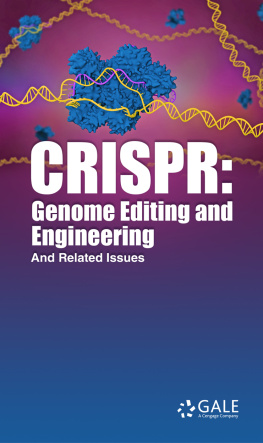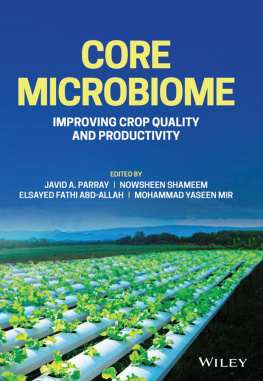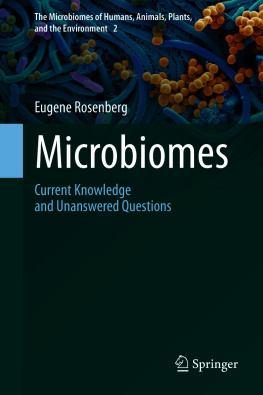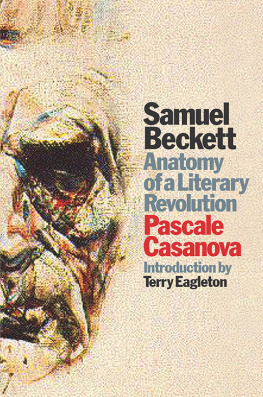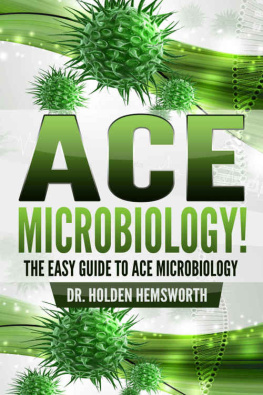Pascale Cossart - The New Microbiology: From Microbiomes to CRISPR
Here you can read online Pascale Cossart - The New Microbiology: From Microbiomes to CRISPR full text of the book (entire story) in english for free. Download pdf and epub, get meaning, cover and reviews about this ebook. year: 2020, genre: Romance novel. Description of the work, (preface) as well as reviews are available. Best literature library LitArk.com created for fans of good reading and offers a wide selection of genres:
Romance novel
Science fiction
Adventure
Detective
Science
History
Home and family
Prose
Art
Politics
Computer
Non-fiction
Religion
Business
Children
Humor
Choose a favorite category and find really read worthwhile books. Enjoy immersion in the world of imagination, feel the emotions of the characters or learn something new for yourself, make an fascinating discovery.
- Book:The New Microbiology: From Microbiomes to CRISPR
- Author:
- Genre:
- Year:2020
- Rating:5 / 5
- Favourites:Add to favourites
- Your mark:
- 100
- 1
- 2
- 3
- 4
- 5
The New Microbiology: From Microbiomes to CRISPR: summary, description and annotation
We offer to read an annotation, description, summary or preface (depends on what the author of the book "The New Microbiology: From Microbiomes to CRISPR" wrote himself). If you haven't found the necessary information about the book — write in the comments, we will try to find it.
The New Microbiology: From Microbiomes to CRISPR — read online for free the complete book (whole text) full work
Below is the text of the book, divided by pages. System saving the place of the last page read, allows you to conveniently read the book "The New Microbiology: From Microbiomes to CRISPR" online for free, without having to search again every time where you left off. Put a bookmark, and you can go to the page where you finished reading at any time.
Font size:
Interval:
Bookmark:

NEW
Microbiology
Pascale Cossart
Institut Pasteur
Paris, France

Cover image: Bacillus subtilis bacteria in the process of sporulation. The spore membrane is green and the bacterial membrane is red. Courtesy of Javier Lopez Garrido and Kit Pogliano, University of California, San Diego.
Translation of La nouvelle microbiologie: Des microbiotes aux CRISPR by Pascale Cossart, (C) ODILE JACOB, 2016
Copyright 2018 by ASM Press. ASM Press is a registered trademark of the American Society for Microbiology. All rights reserved. No part of this publication may be reproduced or transmitted in whole or in part or reutilized in any form or by any means, electronic or mechanical, including photocopying and recording, or by any information storage and retrieval system, without permission in writing from the publisher.
Disclaimer: To the best of the publishers knowledge, this publication provides information concerning the subject matter covered that is accurate as of the date of publication. The publisher is not providing legal, medical, or other professional services. Any reference herein to any specific commercial products, procedures, or services by trade name, trademark, manufacturer, or otherwise does not constitute or imply endorsement, recommendation, or favored status by the American Society for Microbiology (ASM). The views and opinions of the author(s) expressed in this publication do not necessarily state or reflect those of ASM, and they shall not be used to advertise or endorse any product.
Library of Congress Cataloging-in-Publication Data
Names: Cossart, Pascale, author.
Title: The new microbiology : from microbiomes to CRISPR / Pascale Cossart, Institut Pasteur, Paris, France.
Other titles: Nouvelle microbiologie. English
Description: Washington, DC : ASM Press, [2018] | Includes bibliographical references and index.
Identifiers: LCCN 2018001322 (print) | LCCN 2018003826 (ebook) |
ISBN 9781683670117 (e-book) | ISBN 9781683670100 |
ISBN 9781683670100 (print)
Subjects: LCSH: Microbiology.
Classification: LCC QR41.2 (ebook) | LCC QR41.2 .C6713 2018 (print) |
DDC 579dc23
LC record available at https://lccn.loc.gov/2018001322
doi:10.1128/9781683670117
Address editorial correspondence to: ASM Press, 1752 N St., NW, Washington, DC 20036-2904, USA.
Send orders to: ASM Press, P.O. Box 605, Herndon, VA 20172, USA.
Phone: 800-546-2416; 703-661-1593. Fax: 703-661-1501.
E-mail:
Online: http://www.asmscience.org
For many of us, the word microbe still conjures a negative image, one of sickness, infection, or contamination. In general, we do not wonder Where does this microbe come from? except in case of an epidemic. We simply observe that its presence is inopportune and is dismantling a preestablished order, an equilibrium: this well-being that is named health.
We now know, however, that good health depends on the presence of millions of beneficial microbes and microorganisms. These live on our skin and in different places in our bodies, such as the intestine, the mouth, and the nose, or they participate in various processes, such as the making of cheese, yogurt, and other foods, or water treatment and environment decontamination. They play a key role in maintaining the stability of our environment and the biodiversity of the flora and fauna of our planet.
Thanks to the studies of Louis Pasteur and Robert Koch at the end of the 19th century, it is well established that microbes do not spontaneously generate, that each microbe is born from another microbe, and that the smallest living organisms capable of autonomous life are called bacteria (from the Greek bakteria, meaning a stick or rod, named for the rod-like shape of the first observed bacteria). These bacteria, observable with simple microscopes, are single-celled organisms that can generate thousands of similar unicellular daughter cells.
Louis Pasteur and Robert Koch importantly discovered that bacteria were responsible for numerous diseases that have devastated humanity for thousands of years, such as the plague, cholera, and tuberculosis. Their studies paved the way for powerful methods of diagnosis of, and treatment for, bacterial infections, and for the development of vaccines, some of which are still being used today. Pasteur and Koch also introduced the concept of the study of bacteria in general, whatever their naturei.e., either pathogenic, illness-generating bacteria or nonpathogenic bacteria that carry out other functions. In fact, the discoveries of Pasteur, Koch, and their collaborators were so revolutionary and so important that by the early 20th century they triggered an immense interest, first among medical doctors and then among biologists of all sorts attracted to this new discipline: microbiology, the study of various microorganisms invisible to the naked eye, and more specifically, bacteriology, the study of bacteria.
During this flourishing period and the entire century that has followed, the field has advanced by leaps and bounds in many directions. At first, shortly after Pasteur and Koch, microbiology developed rather slowly, with the meticulous identification of all kinds of bacteria, the establishment of various collections, and diverse classifications and precise descriptions. Then things really sped up. In the early 1950s, the discovery of DNA as the basis of the genetic material of all living organisms, combined with the previous research on bacteria, quickly led to the development of concepts that applied, as Nobel laureate Jacques Monod put it, to the bacterium as much as to the elephant. These concepts included DNA replication, DNA transcription, protein translation, and protein synthesis. This in turn led to the development of molecular biology and genetic engineering: the art of manipulating genes and species.
By the end of the 20th century, technologies in DNA sequencingthe determination of the structure of genes and, soon, of complete bacterial genomessparked a totally unexpected acceleration in the study of bacteria, both pathogenic and not. Our understanding of infectious diseases was completely redefined by these approaches that, in association with cellular biology techniques such as imaging, started to shed light on the multiple mechanisms used by microorganisms to establish infection by interacting in various ways with the infected host and by harnessing many of the hosts essential functions and fundamental mechanisms.
In parall el with this new vision on infectious diseases, research on the behavior of bacteria has shown that all bacteria without exception have a social life. They can live in small groups and diverse communities known as biofilms present on all kinds of surfaces. They can live in harmony with their fellow bacteria in heterogeneous, but stable, groups. When these groups grow in size and associate with other microorganisms, including parasites or viruses, they are called microbiomes. What was once known as the intestinal flora is now termed the intestinal microbiome. The intestinal microbiome is not the only type of microbiome; other parts of the body, and other organisms, feature their own. We now know that these microbiomes evolve and that they are unique to the individual they inhabit, based on their hosts specific eating habits, genetic heritage, underlying illnesses, and even personal behavior.
Next pageFont size:
Interval:
Bookmark:
Similar books «The New Microbiology: From Microbiomes to CRISPR»
Look at similar books to The New Microbiology: From Microbiomes to CRISPR. We have selected literature similar in name and meaning in the hope of providing readers with more options to find new, interesting, not yet read works.
Discussion, reviews of the book The New Microbiology: From Microbiomes to CRISPR and just readers' own opinions. Leave your comments, write what you think about the work, its meaning or the main characters. Specify what exactly you liked and what you didn't like, and why you think so.

